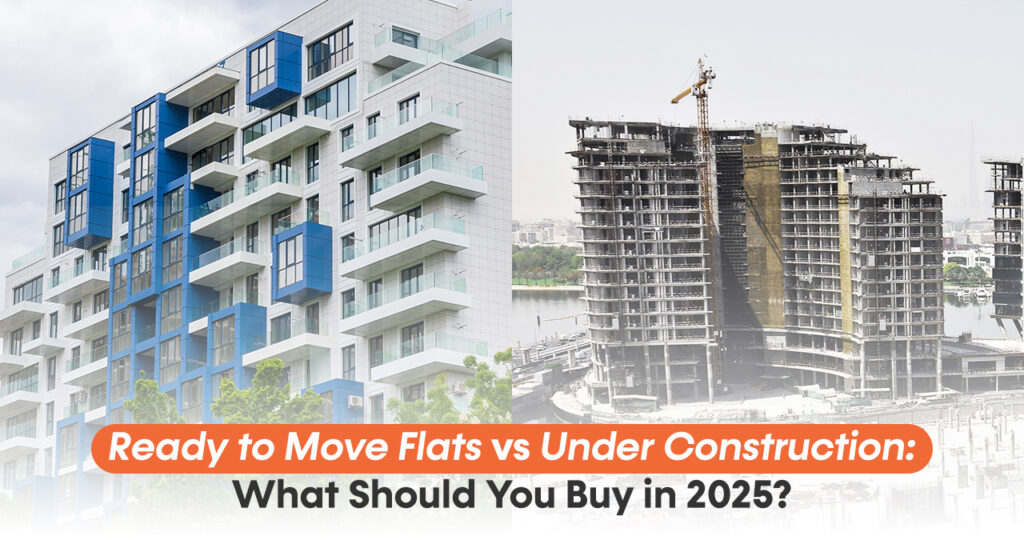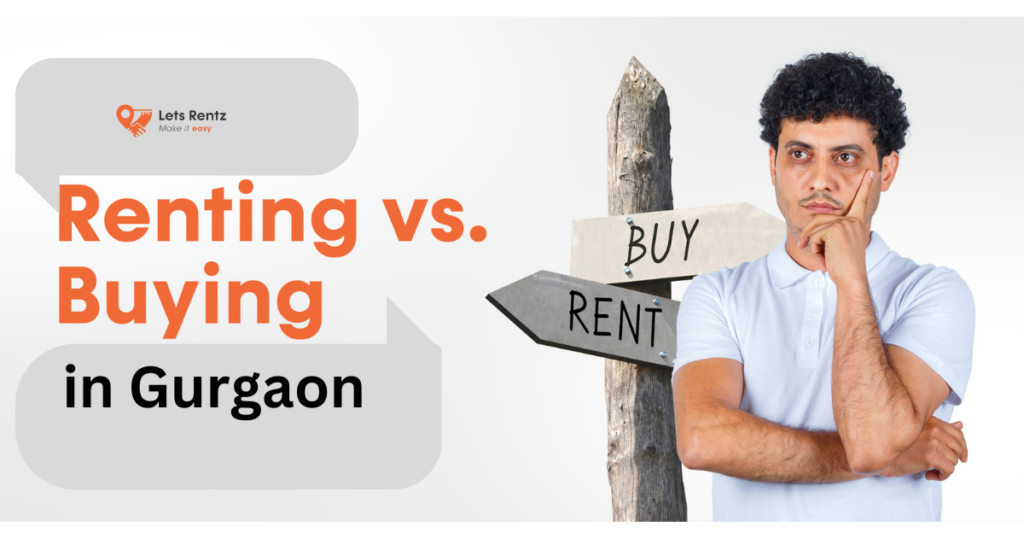The Indian real estate market in 2025 is buzzing with opportunities, driven by rapid urbanization, economic growth, and evolving buyer preferences. With the industry expected to reach a market size of USD 1 trillion by 2030 and contribute 13% of India’s GDP by 2025, homeowners must make a crucial choice: should you invest in ready-to-move flats or opt for an under-construction property? Both options have unique advantages and challenges, and choosing the right one depends on your financial goals, timeline, and risk appetite. This article dives deep into the pros, cons, market trends, and key considerations to help you make an informed decision in 2025.
Understanding Ready to Move Flats and Under Construction Properties
What Are Ready to Move Flats?
Ready to move flats are fully constructed residential properties that have received an Occupancy Certificate (OC) or Completion Certificate (CC) from the relevant authorities. These homes are available for immediate possession, allowing buyers to move in without delay. In 2025, ready to move flats are in high demand in cities like Mumbai, Bengaluru, Delhi NCR, Pune, and Hyderabad, where buyers prioritize convenience and certainty.
What Are Under Construction Properties?
Under construction properties: Residential projects that are still in the development stage are known as under construction properties.. These properties are typically sold by developers before completion, often at lower prices than ready-to-move flats. Buyers pay in installments based on construction progress, and possession is delivered upon project completion, which could take anywhere from 1 to 5 years, depending on the project.
Why the Choice Matters in 2025
The Indian real estate market in 2025 is shaped by several factors:
- Urbanization and Demand: With 5.44 lakh housing units registered in FY25, a 77% increase from FY19, residential demand is soaring, especially for ready to move flats in Tier-1 cities.
- Luxury Segment Growth: Luxury housing sales (properties priced above ₹1 crore) accounted for over 50% of sales in 2024, with a 53% surge in seven major cities.
- Price Appreciation: Average housing prices rose 11% YoY in Q3 2024, with Delhi NCR seeing a 32% increase and Bengaluru 24%.
- Government Policies: Initiatives like the Pradhan Mantri Awas Yojana (PMAY) and 100% profit deductions for affordable housing construction are boosting the market.
- GST Implications: Ready to move flats with an OC are exempt from GST, while under construction properties attract 5% GST (1% for affordable housing).
Given these dynamics, understanding the pros and cons of each option is crucial for making a smart investment in 2025.
Advantages of Ready to Move Flats
1. Immediate Possession
One of the biggest advantages of ready-to-move flats is the ability to move in right after purchase. This is ideal for homebuyers who need immediate housing, such as families relocating for work or those tired of paying rent. In 2025, with rental markets slowing down due to rising EMI affordability, ready to move flats are a practical choice.
2. No GST
A valid occupancy certificate exempts ready-to-move-in apartments from the Goods and Services Tax (GST). This can result in significant savings compared to under-construction properties, which are taxed at 5% (or 1% for affordable housing). For example, a ₹50 lakh under-construction flat attracts ₹2.5 lakh in GST, while a ready-to-move flat of the same value incurs no GST.
3. Transparency and Quality Assurance
Buyers can personally inspect ready-to-move-in apartments before making a purchase. You can evaluate construction quality, finishes, amenities, and even the view from the flat. This eliminates the reliance on architectural drawings or sample flats, reducing the risk of discrepancies between promised and delivered features.
4. Lower Risk
Ready to move flats eliminate risks associated with project delays, developer insolvency, or regulatory hurdles. In 2025, with new RERA rules and stricter compliance, the risk of stalled projects remains a concern for under construction properties. Ready to move flats offer peace of mind, as the project is already completed.
5. Immediate Rental Income
Ready-to-move-in apartments allow investors to start making money right now. With India’s rental market stabilizing in 2025, particularly in commercial hubs like Bengaluru and Mumbai, this makes ready to move flats an attractive option for those seeking passive income.
Disadvantages of Ready to Move Flats
1. Higher Cost
Due to their quick availability and completed status, ready-to-move-in apartments are usually 10–20% more expensive than homes that are still under development. In 2025, with property prices expected to rise by 5-8% in cities like Mumbai and Delhi NCR, this price gap could be significant.
2. Limited Customization
Unlike under construction properties, ready to move flats offer little to no scope for customizing layouts, fittings, or interiors. Buyers must accept the existing design, which may not suit specific preferences.
3. Missed Appreciation Potential
Under construction properties often appreciate in value during the construction phase due to market trends or infrastructure developments. Ready to move flats miss this phase of potential value increase, which could impact long-term returns for investors.
Advantages of Under Construction Properties
1. Lower Initial Cost
Under-construction properties are generally cheaper than ready-to-move flats, making them attractive for budget-conscious buyers. In 2025, with property prices rising, this cost advantage can help buyers enter premium markets like Mumbai or Bengaluru at a lower entry point.
2. Flexible Payment Plans
Buyers of under construction properties typically pay in installments linked to construction milestones, spreading the financial burden over time. This is a significant advantage for young or first-time homebuyers in 2025, as it aligns with their income growth.
3. Potential for Appreciation
Under construction properties can appreciate significantly by the time construction is complete, especially in rapidly developing areas like Noida, Greater Noida, or Tier-2 cities. For instance, average residential prices in Greater Noida jumped 92% from ₹3,340/sq.ft. in Q1 2020 to ₹6,600/sq.ft. in Q1 2025.
4. Customization Options
Buyers of under construction properties often have the flexibility to customize layouts, fittings, or interiors, allowing for a personalized home. This is particularly appealing in 2025, as buyers increasingly demand tech-enabled and sustainable homes.
5. Modern Amenities
Under construction projects in 2025 often incorporate the latest trends, such as AI-driven security, energy-efficient systems, and green building materials. These features align with the growing demand for sustainable and smart homes.
Disadvantages of Under Construction Properties
1. Risk of Delays
Delays in project completion remain a significant risk for under-construction properties. In 2025, despite stricter RERA regulations, unforeseen issues like funding shortages or regulatory hurdles can push possession dates by months or even years.
2. GST Applicability
Under construction properties attract 5% GST (1% for affordable housing), increasing the overall cost. Buyers cannot claim Input Tax Credit (ITC), which could have offset some expenses.
3. Developer Reliability
The success of an under construction property hinges on the developer’s financial stability and track record. In 2025, while major players like Godrej Properties, Lodha Group, and Prestige Group dominate, smaller developers may face challenges, risking project abandonment.
4. Uncertainty in Quality
Buyers rely on sample flats or renderings, which may not accurately reflect the final product. Construction quality, amenities, or promised features may fall short, leading to dissatisfaction.
5. No Immediate Returns
Because ownership is delayed, under-construction properties do not provide investors with instant rental income. This could be a drawback in 2025, with rising demand for rental properties in urban centers.
Market Trends Shaping the Decision in 2025
1. Surge in Luxury and Premium Housing
Sales in 2024 were dominated by the luxury housing category (₹1 crore and above), with an increase of 86% in the ₹3-5 crore segment and 80% in the ₹5 crore+ segment. Both ready to move flats and under construction properties in this category are in demand, driven by high-net-worth individuals (HNIs) and NRIs.
2. Rise of Tier-2 and Tier-3 Cities
Government initiatives like the Smart Cities Mission and AMRUT are transforming Tier-2 and Tier-3 cities like Ahmedabad, Lucknow, and Indore into residential hubs. Under construction properties in these cities offer high ROI potential due to lower entry costs and improving connectivity.
3. Technology Integration
Both ready to move flats and under construction properties are adopting smart technologies in 2025, including virtual tours, AI-based assistance, and automated home systems. Under construction projects have an edge here, as they can integrate these features from the design phase.
4. Sustainability Focus
Green building practices are a priority in 2025, with developers incorporating energy-efficient systems and sustainable materials. This trend is more prevalent in under construction properties, aligning with buyer demand for eco-friendly homes.
Key Considerations for Choosing in 2025
1. Financial Situation
- Ready to Move Flats: Require a higher upfront payment, suitable for buyers with stable finances or those seeking immediate possession.
- Under Construction Properties: Offer flexible payment plans, ideal for young buyers or those with growing incomes.
2. Timeline
- Ready to Move Flats: Best for those needing immediate housing or rental income.
- Under Construction Properties: Suitable for buyers willing to wait 1-5 years for possession and potential appreciation.
3. Risk Tolerance
- Ready to Move Flats: Low risk, as the project is complete and quality can be verified.
- Under Construction Properties: Higher risk due to delays or developer issues, requiring thorough due diligence.
4. Location and Appreciation Potential
- Ready to Move Flats: Ideal in established areas with stable prices, like South Mumbai or Bengaluru’s Whitefield.
- Under Construction Properties: Offer higher appreciation in developing areas like Noida Extension or Hyderabad’s Gachibowli.
5. Developer Reputation
To reduce hazards, select reputable developers such as Lodha, Godrej, or Prestige for properties that are still under development. For ready to move flats, verify the project’s maintenance and society management quality.
Case Study: Mumbai vs. Noida in 2025
Mumbai
- Ready to Move Flats: High demand in areas like Andheri, Bandra, and Worli, with prices ranging from ₹15,000-₹30,000/sq.ft. Ideal for immediate possession and rental income.
- Under Construction Properties: Projects in Navi Mumbai and Thane offer 10-15% lower prices, with strong appreciation potential due to metro expansions.
Noida
- Ready to Move Flats: Projects like ACE City in Greater Noida West offer modern amenities at ₹6,000-₹8,000/sq.ft., appealing to end-users.
- Under Construction Properties: Developments like Godrej Tropical Isle in Sector 146 promise high returns, with prices starting at ₹5,500/sq.ft. and expected 20% appreciation by completion.
Expert Tips for 2025
- Conduct Due Diligence: For under construction properties, verify the developer’s RERA registration, financial stability, and past project delivery. For ready to move flats, check the OC and society maintenance records.
- Evaluate Location: Prioritize areas with upcoming infrastructure, like metro lines or expressways, for higher appreciation.
- Consult Experts: Engage real estate consultants or platforms like Homebazaar.com for end-to-end guidance, from site visits to loan assistance.
- Plan Finances: Include GST for houses that are still under construction and maintenance expenses for apartments that are ready to move into.
- Future-Proof Investments: Choose properties with sustainable features and smart technologies to align with 2025 trends.
Also Read - Real Estate Trends 2025: Where Should You Invest This Year in India?
Conclusion
In 2025, the choice between ready-to-move flats and under-construction properties depends on your priorities. If you seek immediate possession, low risk, and GST savings, ready-to-move flats are the way to go, especially in established markets like Mumbai or Bengaluru. However, if you’re willing to wait for higher returns, have a flexible budget, and want modern amenities, under-construction properties in emerging areas like Noida or Tier-2 cities offer immense potential.
The Indian real estate market is expected to increase at a strong rate between 2023 and 2028, with a predicted CAGR of 9.2%. By aligning your decision with your financial goals, timeline, and market trends, you can make a smart investment that secures your future. Whether you choose the certainty of a ready-to-move flat or the potential of an under-construction property, 2025 promises exciting opportunities for homebuyers and investors alike. Now, very soon, Lets Rentz is launching its Buy and Sell services also in Try City and Delhi NCR. If you want to buy or invest in a property washout brokerage, you can visit Lets Rentz.



